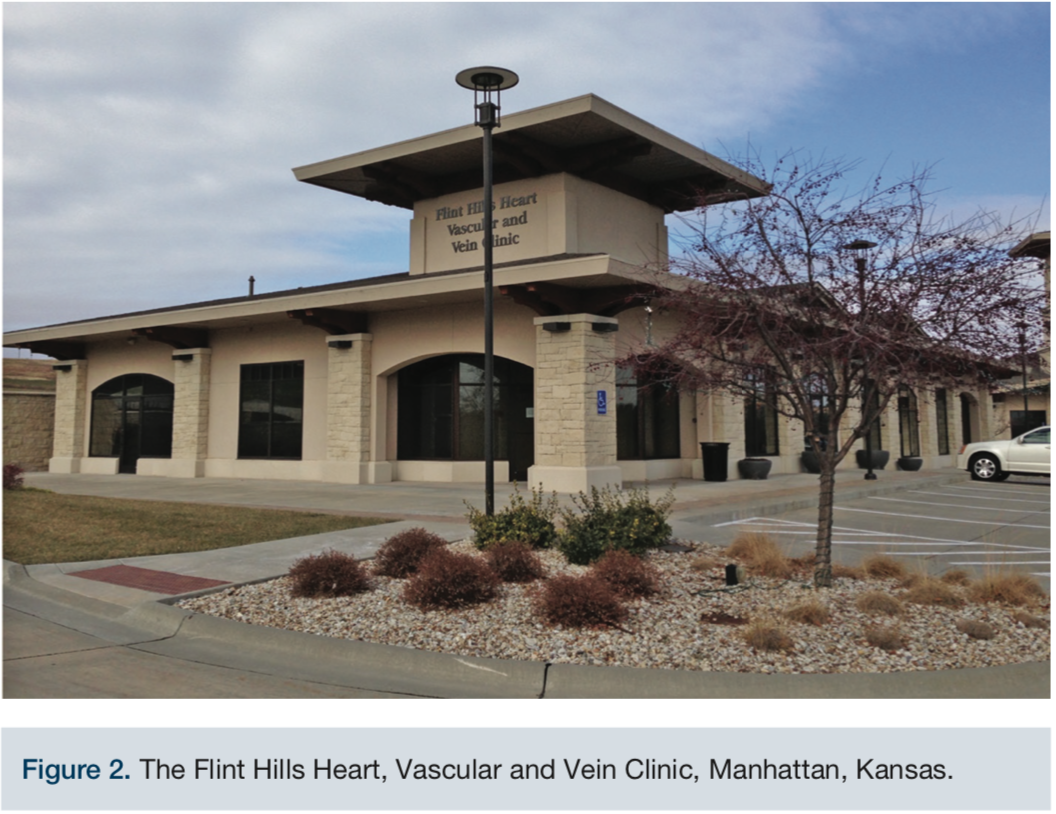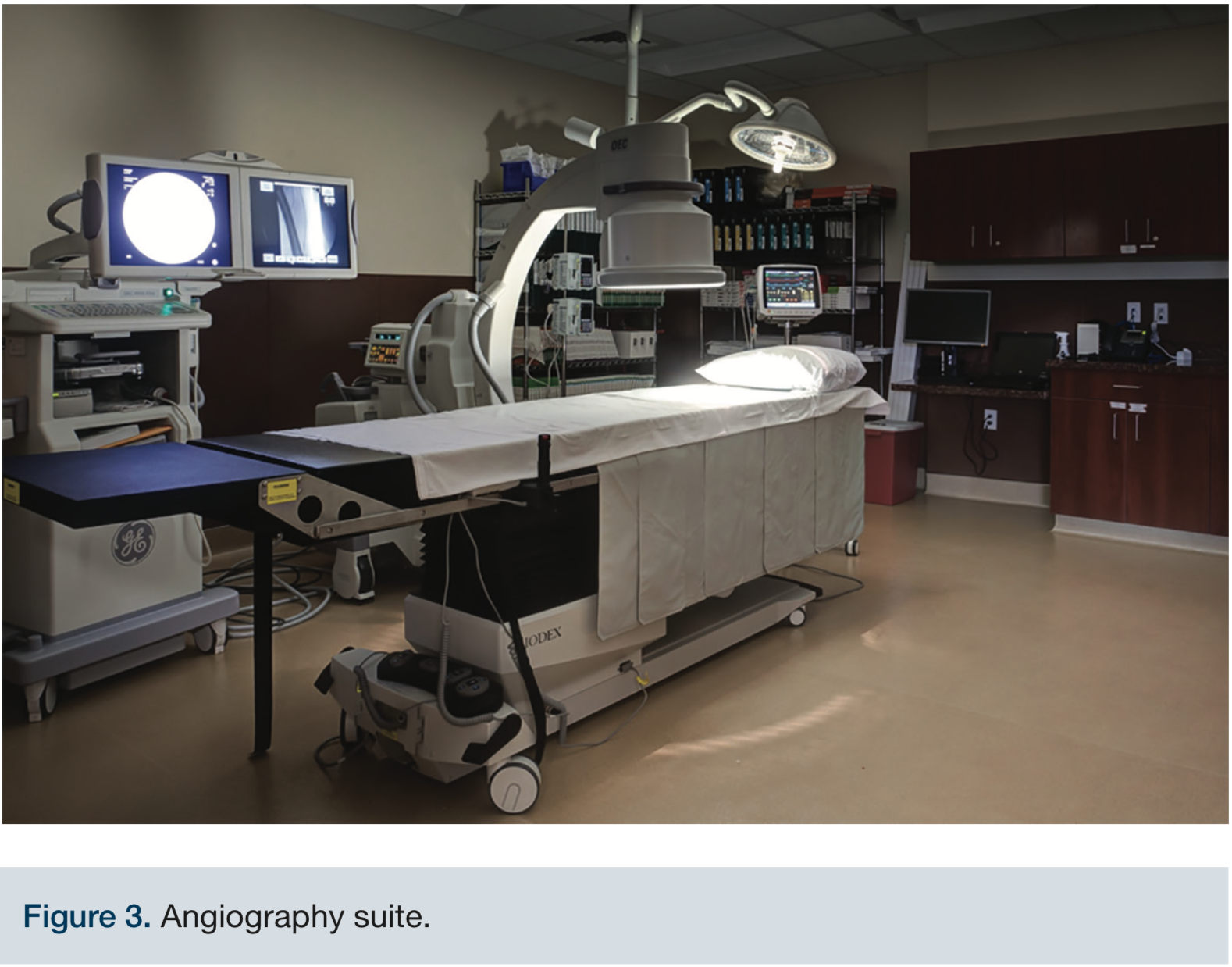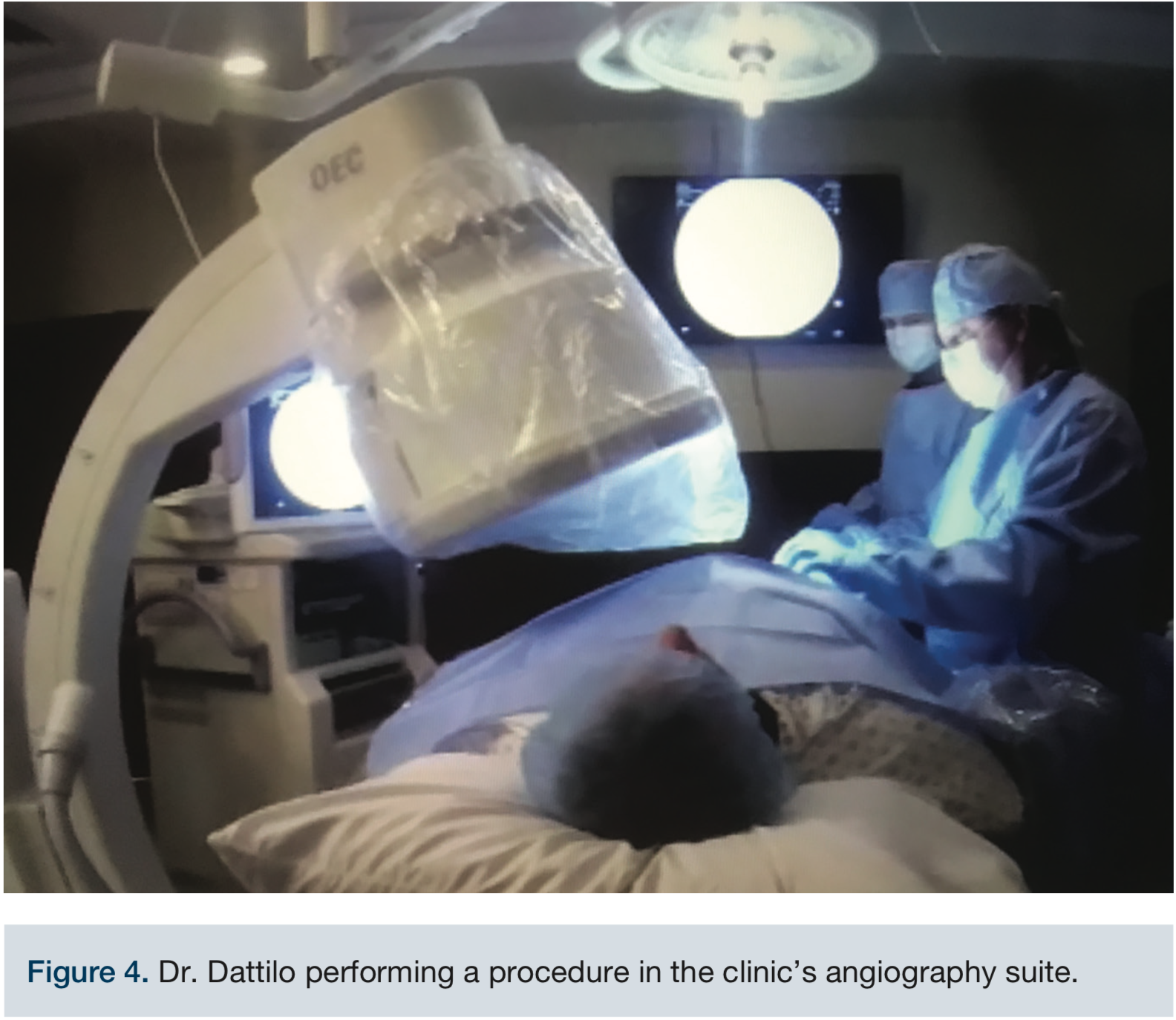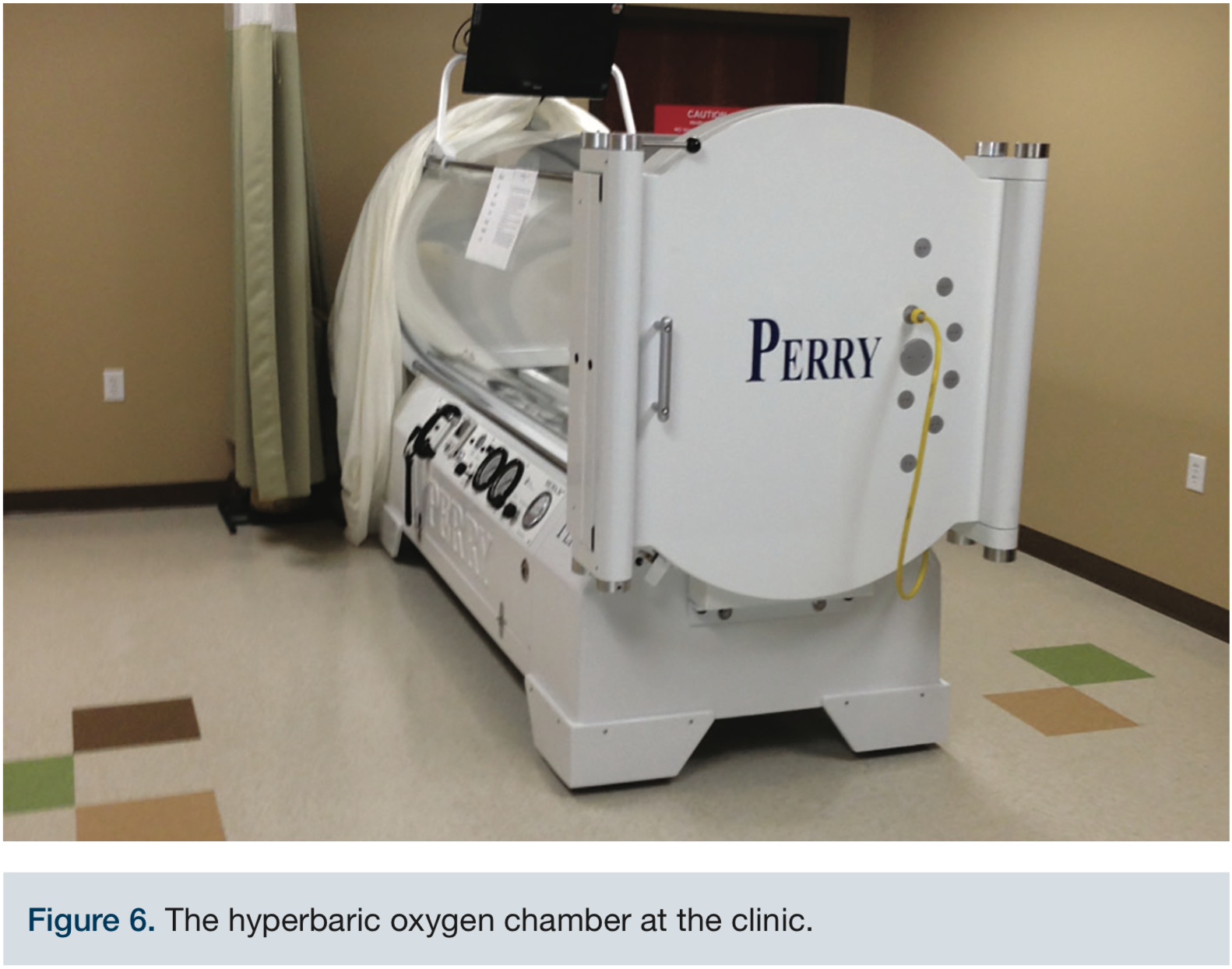ADVERTISEMENT
OBL Spotlight: Flint Hills Heart, Vascular and Vein Clinic
Prior to opening an office-based lab (OBL), I worked as an interventional cardiologist for 25 years at a hospital in Topeka, Kansas, doing both cardiac and peripheral vascular interventions. As my interest in treating peripheral vascular disease increased, and my enthusiasm for cardiac intervention waned, I found myself increasingly treating patients with critical limb ischemia (CLI). These patients are typically quite ill, the atherosclerotic disease process complex, and the procedures to treat them usually lengthy. Although I was in a private practice with other cardiologists for most of that time, I was hospital-employed during the last several years, and I found that my desire to treat CLI patients was increasingly at odds with the hospital’s bureaucratic plan for my time. This frustration ultimately led to the idea of opening my own clinic with a focus on treating patients with CLI. It was not a decision to be taken lightly, given the time and money needed for such an endeavor, and it wasn’t until May of 2013 that I decided to go forward with the plan.
There are several factors to be considered prior to embarking on such an venture, including: (1) where should it be located; (2) where will my patients come from; (3) should I have partners (additional providers and/or investment/management partners); (4) what services should the clinic provide; (5) what equipment will I need for these services; (6) how much space will I need; (7) what will all this cost; and (8) will I be able to get a loan from the bank? In the end, regarding the question of partners, I decided to go it alone. There just were not any other physicians in the region with the skillset and the desire to treat patients with CLI. In addition, I wasn’t sure that I would have the patient volume, at least at the beginning, to support more than one physician — and the financial commitment of an OBL is substantial.
I immediately hired a consultant (Spectra Contracting, Inc.) to help me put this all together. Spectra Contracting is a firm that is familiar with what is needed to plan and construct an OBL, from finding the space, to building out the structure, to helping put together a pro forma to secure a bank loan, and assisting in hiring the necessary staff. I chose a location approximately 1 hour west of Topeka (where I had been practicing up to that point). I did not have a non-compete clause in my contract, but that is certainly something which one would have to consider from the outset. I chose Manhattan, Kansas, because I had already been receiving a number of referrals from this region and it put me far enough away from Topeka to minimize competition from there, while still being close enough for my current patients to continue to see me, if they chose to do so. In addition, it gave me access to new patients in more western parts of Kansas. Manhattan has a community-based hospital that would at least provide the necessary emergency services in the event of a procedural complication, although more complex problems would have to transfer to Topeka for treatment. Importantly, there was no competition for CLI intervention in Manhattan and its surrounding region.
Many patients with CLI present with nonhealing foot wounds. Consequently, the endovascular specialist treating CLI has to work hand-in-glove with a wound clinic. In fact, a multidisciplinary team is often needed to treat complex CLI patients (but that is another subject). I had noted in my own patients that communication between various wound clinics and a vascular specialist like myself was suboptimal. Patients with extensive wounds and severe arterial insufficiency can take 6 months to a year to heal, and communication must be frequent and ongoing. Some of these patients will need a reintervention to maintain adequate blood flow for wound healing. The need for reintervention may be suspected when a wound that had been showing progressive healing suddenly slows or stops healing. In my experience, many of these patients will be referred for limb amputation at that point, if the problem is not brought promptly to the interventionist’s attention, under the mistaken belief that everything that could be done to heal the wound has been done. Wound care in the region where I was to set up my new clinic was quite basic and the needs of the CLI patient were not fully appreciated. I felt that in order for me to provide my CLI patients with optimal care, I needed to incorporate a wound clinic within my facility. So, I received additional training in wound care, hired an experienced wound care nurse, and put the wound center into the blueprints. From the time I decided to open an OBL until the day we opened the door, it was roughly 6 months. The building I chose was a recently constructed outer shell of 6,250 square feet and so I was able to build out the interior to my specifications, including an angiographic lab with a state-of-the-art motorized C-arm. I was surprised by the high quality of the images from the C-arm, and happy to save hundreds of thousands of dollars compared to a fixed unit. The clinic also has a second lead-lined room to allow for expansion if business so dictates, a 4-bed pre-op/recovery area with nursing station, 3 exam rooms, 3 offices, 2 waiting areas (one for wound care only), the ultrasound/vascular testing/vein procedure room, break/lunch room, doctors’ lounge with sleeping capability, and a wound center complete with hyperbaric oxygen chamber. My employees consist of 3 nurses (one for the wound clinic), an ultrasonographer, scrub technologist (one of my nurses is cross-trained in addition), and 2 administrative personnel up front. My billing is outsourced, but we have in-house software to track the billing as well.
I am often asked about my relationship with the local hospital and other physicians. I chose not to get hospital privileges when I opened the clinic. It is a small community hospital and would not offer me any services beyond what I can provide at my clinic with regard to vascular management. I could send a patient there if he or she needed emergency care for some reason, but that has not been necessary thus far, at 5 years and counting. Hospital privileges would be necessary if the potential OBL physician chose to include invasive cardiology within the OBL practice. I did not want hospital obligations (e.g., call) to detract from time spent at my OBL, although I wouldn’t generally recommend this approach, unless the practitioner has a large interventional experience. For most physicians starting an OBL, I would advise obtaining (or keeping) hospital privileges, and using the OBL for more straightforward cases, increasing the complexity of cases as experience grows. In the OBL, if there is a problem, there is no code team to call; you must be able to stabilize and treat the patient on site. My staff and I do routine training for these scenarios so that we are prepared for an emergency when it occurs; everyone knows exactly what their job is. The local hospital and its physicians do not view our clinic as competition, because CLI patients in the region have largely been untreated. Since we do not do coronary intervention, we do not infringe upon that existing care pathway. To further inspire confidence among referring physicians regarding our clinic, we received accreditation from the Accreditation Association for Ambulatory Health Care (AAAHC) in 2017, which distinguishes our outpatient facility from many others by providing the highest quality care to its patients, as determined by an independent, external process of evaluation. We also participate in the Vascular Quality Initiative (VQI) registry so that we have data demonstrating ongoing assessment of the quality of the work being done at our clinic and which we can present to any interested parties (government agencies, payors) if necessary. I highly recommend any OBL participate in at least one national registry and work toward accreditation.
Not surprisingly, many patients coming in for angiography are first seen in the wound clinic (approximately 20% of our arterial angiography volume). This is one advantage of an integrated wound center I did not initially fully anticipate. Patients are often referred simply for wound care, but when appropriate, and based upon history and physical exam, vascular testing may be performed. Vascular testing in these cases sometimes demonstrates severe arterial insufficiency, which might otherwise have been missed in some wound clinics and which may be causally related to wound development or nonhealing. After revascularization, we follow the patient closely in the wound center and ensure that wound healing progresses as anticipated. We have a wound camera and software program that calculates the wound volume and plots it on a graph so we can readily see if the rate of healing slows, possibly suggesting significant recurrent arterial obstructive disease. In this circumstance, we could readily further evaluate the patient with noninvasive vascular studies and quickly correct the problem with another endovascular procedure, if needed, with little interruption in the wound healing process. If the patient is already being treated in another wound clinic, we send them back to that wound clinic for follow-up and keep our lines of communication with them open. We do provide education to outside wound clinics as needed to ensure an optimal understanding of the role of vascular disease in wound management.
Approximately 60% of our arterial interventions are for CLI and the rest are for claudication. We treat all comers in our interventional lab, with more than 1,000 interventions thus far, all of which have been discharged home the same day. Eighteen percent of our CLI intervention patients are Rutherford class 6, the most severe cases. Many of our treated patients have multilevel chronic total occlusions. There is no disease complexity that we feel uncomfortable treating in the OBL. We have been using tibio-pedal access, when appropriate, since we opened the clinic and this access has helped us to be successful in some of the more complex cases. We also use ultrasound-guided access in most cases. Data compiled from our first 3 years of operation1 show an amputation-free survival rate of 83% (and 94% freedom from major amputation in patients surviving at least 1 year), rivaling or surpassing that of other published series, none of which are OBL based. Access site problems represent the greatest source of complications in interventional patients. We used vascular closure devices in 97% of the femoral access cases in this series to mitigate any potential access site complications and give us the confidence to send these patients home the same day.
Because of our wound clinic, we see a number of patients with venous ulcers. Consequently, we also do a fair number of venous procedures including saphenous vein ablation, stab phlebectomy and, increasingly, iliac vein stenting for iliac vein compression syndrome (May-Thurner). Some patients have combined venous and arterial disease. We recently saw a patient with nonhealing venous ulcer of the right ankle that had been treated in another wound clinic for 9 months. During this time he had a saphenous vein ablation in Topeka without improvement in his severe leg swelling. He came to see us for a second opinion. I could not palpate, or even Doppler, a posterior tibial artery (PT) pulse on exam. His swelling, which continued above the knee, was suggestive of iliac vein obstruction. Arterial and venous duplex scans suggested total occlusion of the PT (the artery feeding the wound, using angiosome mapping), and loss of phasicity in the venous flow pattern suggested iliac vein compression. We recanalized his PT with angioplasty and stented a severe stenosis in the right iliac vein with prompt healing of the wound. I would not have seen this patient if I had not had a wound clinic and he would still have an ulcer.
On the business side, as I said at the outset, I chose not to partner with any of the national companies whose business is to help you establish and run the clinic, though not for lack of their asking. In essence, these companies give you some money (negotiable) up front for a piece of your business ownership, in exchange for their expertise in setting up the clinic. In addition, they are also paid a management fee monthly. For those physicians that feel they need some hand-holding through this process, then this might be a good fit. I personally did not want to relinquish a significant stake in my clinic ad infinitum. That means there is more work to be done by the physician(s) if you go it alone, beginning with setting up an LLC, contracting with an outfit experienced in building OBLs, getting a sizable bank loan, hiring employees, hiring a billing service, etc. Although this initial part is time consuming, at the end of the process, the physician(s) have complete ownership and control of the clinic. I will say I had concerns about whether the clinic would provide the volume of business needed to be reasonably profitable, but these concerns have now, more than 5 years out, proved unwarranted. It is critical to be reasonably certain that you will have the support of enough physicians to ensure an adequate referral base and that your services will fill a need in the community. However, many of my patients come to my clinic as self-referrals as a result of community outreach programs and advertising. It is important to hire a business manager to take care of some of the many administrative tasks, and an IT person, since everything is computerized. In general, it helps to hire the most experienced people you can find as employees. There are a lot of rules and regulations to follow from Medicare and private insurers, the state licensing board, state radiation control agency, etc., so you need employees you can trust to get it done, along with a billing service with coders and billers having cardiovascular certification. It is a lot to consider if you try to think about it all at once, so just take it piece by piece as it becomes necessary. The vendors have generally treated me well with respect to pricing of product, but you have to do your homework. There is adequate competition in most product categories, but some devices are unique, with less wiggle room in pricing. Reimbursement remains good for OBLs and, due to their efficiency, I don’t anticipate that to change for the worse any time soon.
When the clinic opened, I had an open house and invited all of the potential referring physicians and nurse practitioners/physician assistants. I went to many of the physician offices and gave educational lectures. I also lectured to the public. I run ads on television, radio, newspapers, magazines, and online. Many self-referrals are a result of these ads and a cost analysis shows that a healthy advertising budget more than pays for itself. Every market will be different, so there is no one right way to do things. We concentrate on patient satisfaction and the feedback we get has been tremendous.
First, focus on getting good outcomes with no complications. Communicate well with the referring doctors and the interested subspecialists. We fax all notes and reports the day after the visit or procedure. I call doctors to talk to them personally when appropriate; communication is becoming a lost art in the medical field and is greatly appreciated by referring physicians.
Although it is more work than being a hospital-employed physician, the satisfaction derived from being in control of your practice more than offsets the additional work. I believe the pendulum, which has swung to hospital employment for physicians, is swinging back, as physicians are becoming dissatisfied with hospital bureaucracy and the corporate business of patient care. As payors increasingly realize the cost savings of patients treated at OBLs, I expect the trend to continue.
Dr. Raymond Dattilo can be contacted at icardmd@aol.com.
- Dattilo R, Dattilo A, Colby S. Outcomes of patients treated for critical limb ischemia in an outpatient endovascular center. Vascular Disease Management. 2018 June;15(6):E49-E52. Available online at https://www.vasculardiseasemanagement.com/content/outcomes-patients-treated-critical-limb-ischemia-outpatient-endovascular-center-0. Accessed July 11, 2019.















